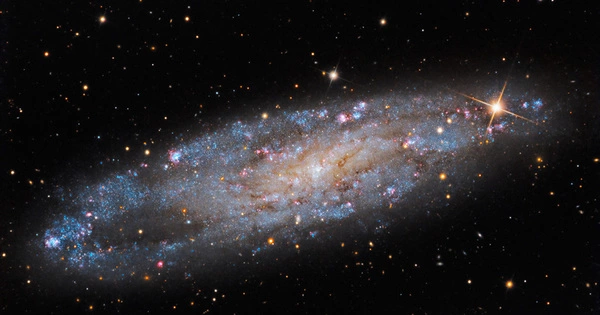NGC 247 (also known as Caldwell 62 and more colloquially as the Claw Galaxy) is an intermediate spiral galaxy (though it is sometimes classified as a dwarf spiral galaxy) located about 11.1 million light-years away in the constellation Cetus. It is a prominent spiral galaxy in the constellation Cetus (the Whale) in the southern sky. In late February 2011, this distance was confirmed. It is a member of the Local Group, which includes the Milky Way, the Andromeda Galaxy, and numerous smaller galaxies.
On one side of NGC 247’s spiral disk, there is an unusually large void. There are some older, redder stars in this void, but no younger, bluer stars. Previous measurements indicated that the galaxy was about 12.2 million light-years away, but this was proven to be incorrect. NGC 247 is a member of the Sculptor Group with a diameter of 70 000 light years.
Key characteristics of NGC 247:
- Morphology: It’s a spiral galaxy, specifically a SAB(rs)cd type. The letter “S” denotes a well-defined spiral structure, the letter “AB” denotes intermediate bar strength, the letter “(rs)” denotes a prominent inner ring, and the letter “cd” denotes loosely wound spiral arms.
- Distance: When compared to most other galaxies in the universe, the galaxy is relatively close. It is estimated to be approximately 11 million light-years away from Earth, making it one of the Milky Way’s closest neighbors.
- Size and brightness: It is about 70,000 light-years across, which is slightly smaller than the Milky Way. It is a relatively bright galaxy that can be seen with telescopes and binoculars from Earth.
- Observational history: The galaxy was first discovered by British astronomer William Herschel in 1784. Since then, it has been a subject of observation and study for astronomers, providing valuable insights into the structure and evolution of spiral galaxies.
- Starburst region: It has an active star formation region known as a starburst region. These are regions with significantly higher rates of star formation than the surrounding regions. Such areas are frequently associated with molecular clouds and intense star-formation activity.
NGC 247 is an intriguing object for astronomers to study because it reveals important details about the structure, dynamics, and star-formation processes in spiral galaxies. Its close proximity to us allows for detailed observations and is critical to our understanding of the Local Group and the larger universe.
















